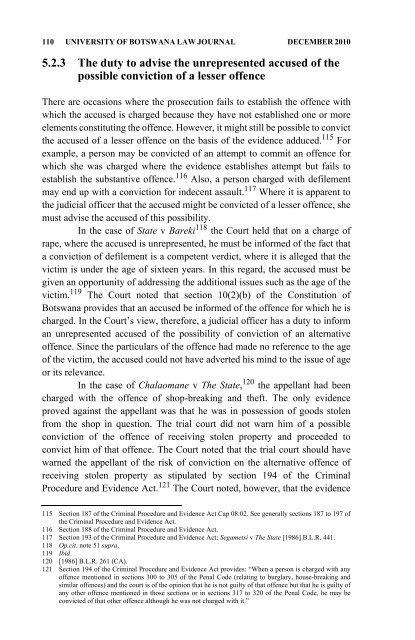University of Botswana Law Journal - PULP
University of Botswana Law Journal - PULP
University of Botswana Law Journal - PULP
Create successful ePaper yourself
Turn your PDF publications into a flip-book with our unique Google optimized e-Paper software.
110 UNIVERSITY OF BOTSWANA LAW JOURNAL DECEMBER 2010<br />
5.2.3 The duty to advise the unrepresented accused <strong>of</strong> the<br />
possible conviction <strong>of</strong> a lesser <strong>of</strong>fence<br />
There are occasions where the prosecution fails to establish the <strong>of</strong>fence with<br />
which the accused is charged because they have not established one or more<br />
elements constituting the <strong>of</strong>fence. However, it might still be possible to convict<br />
the accused <strong>of</strong> a lesser <strong>of</strong>fence on the basis <strong>of</strong> the evidence adduced. 115 For<br />
example, a person may be convicted <strong>of</strong> an attempt to commit an <strong>of</strong>fence for<br />
which she was charged where the evidence establishes attempt but fails to<br />
establish the substantive <strong>of</strong>fence. 116 Also, a person charged with defilement<br />
may end up with a conviction for indecent assault. 117 Where it is apparent to<br />
the judicial <strong>of</strong>ficer that the accused might be convicted <strong>of</strong> a lesser <strong>of</strong>fence, she<br />
must advise the accused <strong>of</strong> this possibility.<br />
In the case <strong>of</strong> State v Bareki 118 the Court held that on a charge <strong>of</strong><br />
rape, where the accused is unrepresented, he must be informed <strong>of</strong> the fact that<br />
a conviction <strong>of</strong> defilement is a competent verdict, where it is alleged that the<br />
victim is under the age <strong>of</strong> sixteen years. In this regard, the accused must be<br />
given an opportunity <strong>of</strong> addressing the additional issues such as the age <strong>of</strong> the<br />
victim. 119 The Court noted that section 10(2)(b) <strong>of</strong> the Constitution <strong>of</strong><br />
<strong>Botswana</strong> provides that an accused be informed <strong>of</strong> the <strong>of</strong>fence for which he is<br />
charged. In the Court’s view, therefore, a judicial <strong>of</strong>ficer has a duty to inform<br />
an unrepresented accused <strong>of</strong> the possibility <strong>of</strong> conviction <strong>of</strong> an alternative<br />
<strong>of</strong>fence. Since the particulars <strong>of</strong> the <strong>of</strong>fence had made no reference to the age<br />
<strong>of</strong> the victim, the accused could not have adverted his mind to the issue <strong>of</strong> age<br />
or its relevance.<br />
In the case <strong>of</strong> Chalaomane v The State, 120 the appellant had been<br />
charged with the <strong>of</strong>fence <strong>of</strong> shop-breaking and theft. The only evidence<br />
proved against the appellant was that he was in possession <strong>of</strong> goods stolen<br />
from the shop in question. The trial court did not warn him <strong>of</strong> a possible<br />
conviction <strong>of</strong> the <strong>of</strong>fence <strong>of</strong> receiving stolen property and proceeded to<br />
convict him <strong>of</strong> that <strong>of</strong>fence. The Court noted that the trial court should have<br />
warned the appellant <strong>of</strong> the risk <strong>of</strong> conviction on the alternative <strong>of</strong>fence <strong>of</strong><br />
receiving stolen property as stipulated by section 194 <strong>of</strong> the Criminal<br />
Procedure and Evidence Act. 121 The Court noted, however, that the evidence<br />
115 Section 187 <strong>of</strong> the Criminal Procedure and Evidence Act Cap 08:02. See generally sections 187 to 197 <strong>of</strong><br />
the Criminal Procedure and Evidence Act.<br />
116 Section 188 <strong>of</strong> the Criminal Procedure and Evidence Act.<br />
117 Section 193 <strong>of</strong> the Criminal Procedure and Evidence Act; Segametsi v The State [1986] B.L.R. 441.<br />
118 Op.cit. note 51 supra.<br />
119 Ibid.<br />
120 [1986] B.L.R. 261 (CA).<br />
121 Section 194 <strong>of</strong> the Criminal Procedure and Evidence Act provides: “When a person is charged with any<br />
<strong>of</strong>fence mentioned in sections 300 to 305 <strong>of</strong> the Penal Code (relating to burglary, house-breaking and<br />
similar <strong>of</strong>fences) and the court is <strong>of</strong> the opinion that he is not guilty <strong>of</strong> that <strong>of</strong>fence but that he is guilty <strong>of</strong><br />
any other <strong>of</strong>fence mentioned in those sections or in sections 317 to 320 <strong>of</strong> the Penal Code, he may be<br />
convicted <strong>of</strong> that other <strong>of</strong>fence although he was not charged with it.”
















